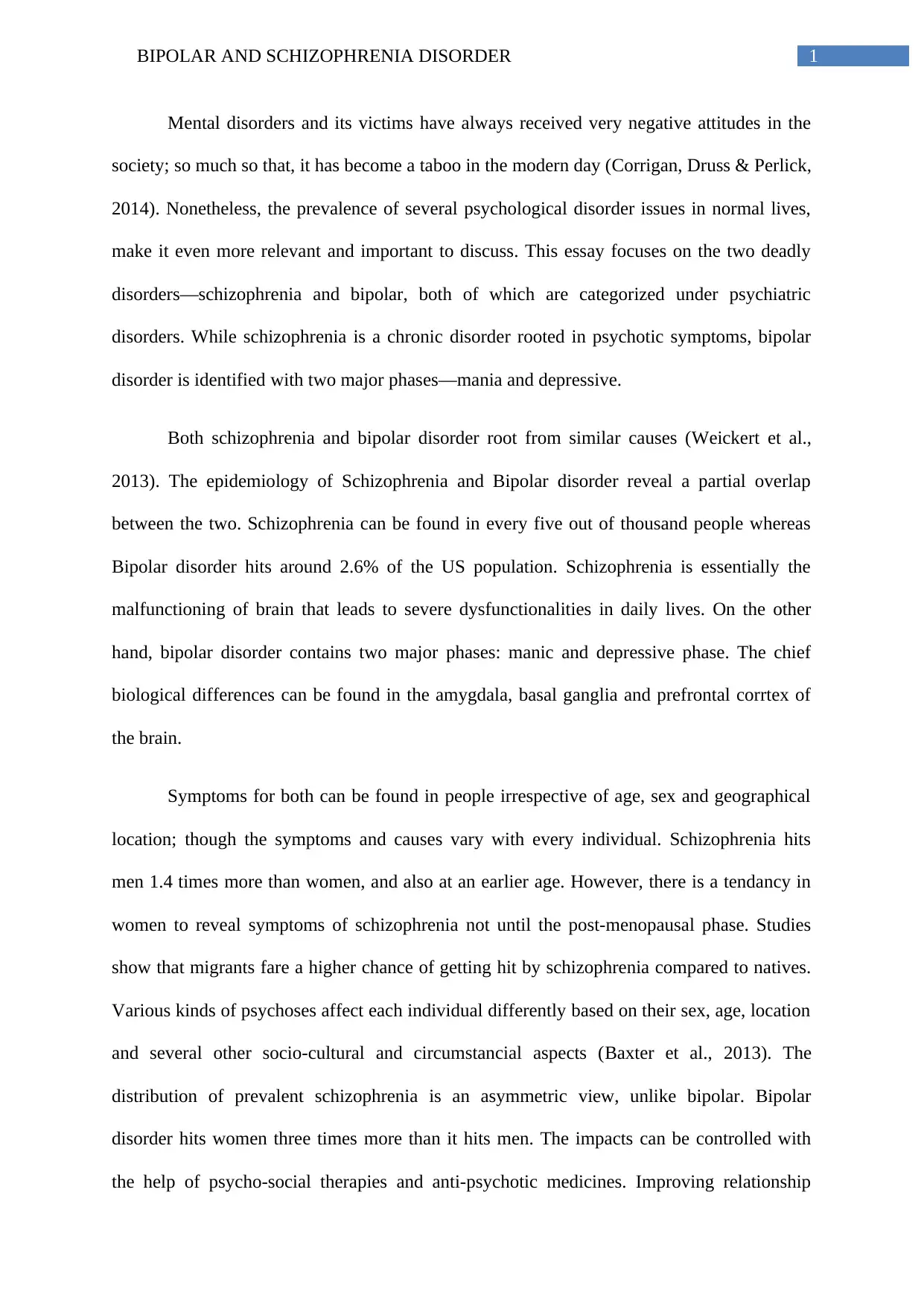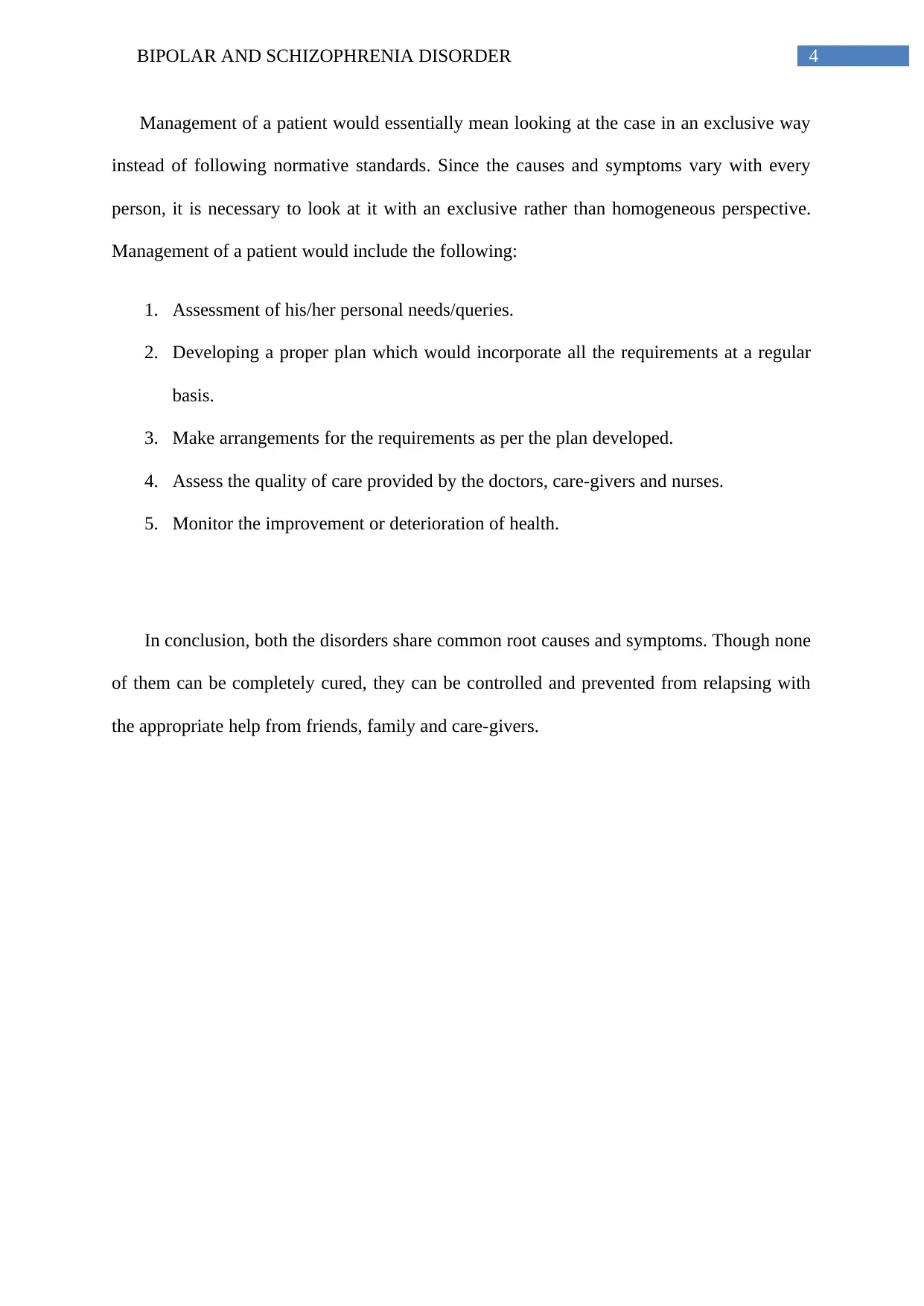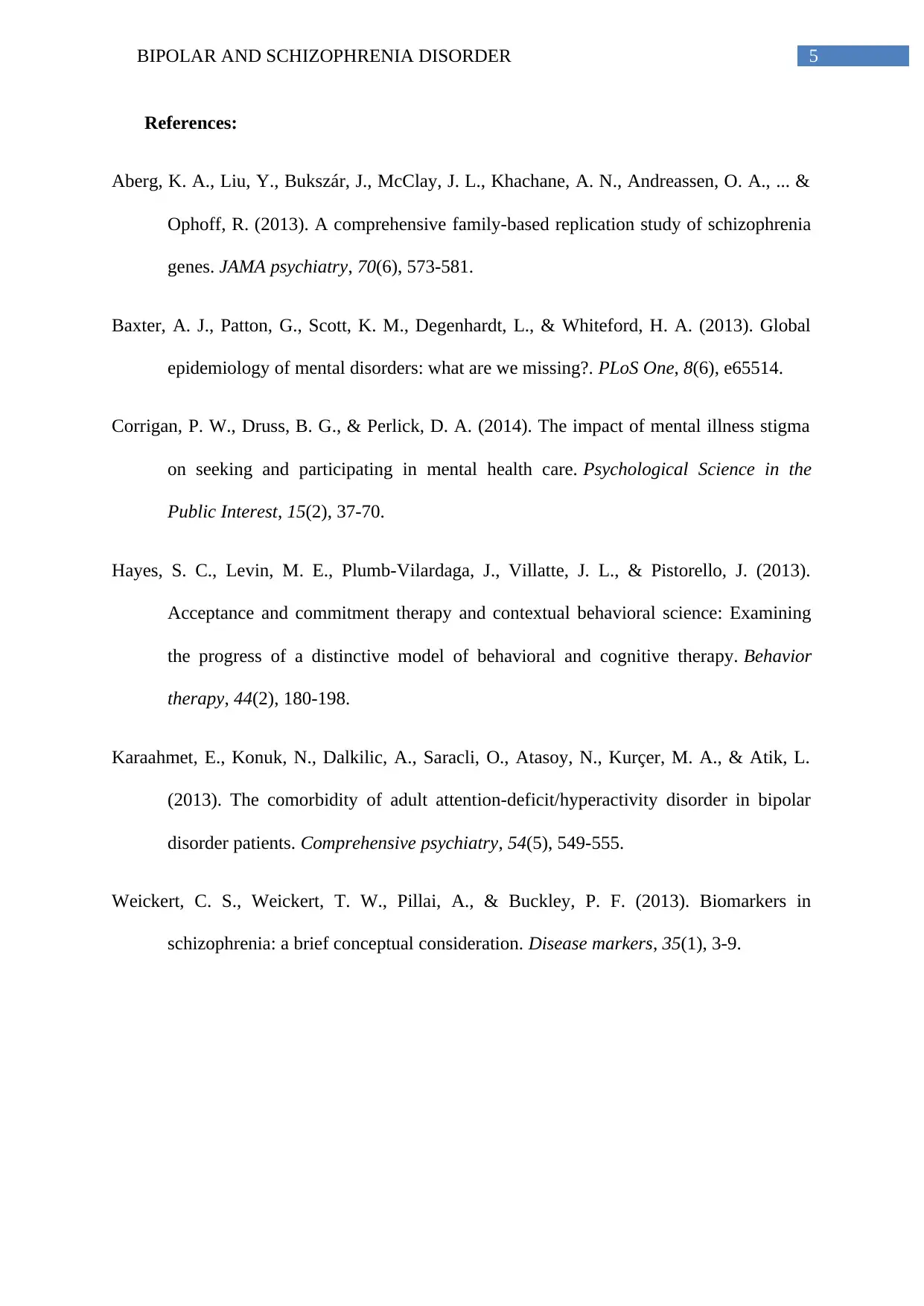Analysis of Schizophrenia and Bipolar Disorder: Symptoms and Treatment
VerifiedAdded on 2023/06/15
|6
|1325
|142
Essay
AI Summary
This essay provides a comparative analysis of schizophrenia and bipolar disorder, both categorized as psychiatric disorders. Schizophrenia, a chronic disorder with psychotic symptoms, is contrasted with bipolar disorder, characterized by manic and depressive phases. The essay explores the epidemiology, pathophysiology, and clinical presentation of both disorders, highlighting similarities in root causes and symptoms, as well as differences in prevalence and biological factors. Diagnostic techniques, including physical examinations and screening tests, are discussed, along with various treatment options such as cognitive therapy, antipsychotic drugs, and community/family interventions. The importance of individualized patient management, focusing on personal needs and continuous assessment of care quality, is emphasized. While neither disorder can be completely cured, the essay concludes that appropriate support from friends, family, and caregivers can effectively control symptoms and prevent relapses. Desklib offers a range of study resources for students.

Running head: BIPOLAR AND SCHIZOPHRENIA DISORDER
BIPOLAR AND SCHIZOPHRENIA DISORDER
Name of Student
Name of University
Author Note
BIPOLAR AND SCHIZOPHRENIA DISORDER
Name of Student
Name of University
Author Note
Paraphrase This Document
Need a fresh take? Get an instant paraphrase of this document with our AI Paraphraser

1BIPOLAR AND SCHIZOPHRENIA DISORDER
Mental disorders and its victims have always received very negative attitudes in the
society; so much so that, it has become a taboo in the modern day (Corrigan, Druss & Perlick,
2014). Nonetheless, the prevalence of several psychological disorder issues in normal lives,
make it even more relevant and important to discuss. This essay focuses on the two deadly
disorders—schizophrenia and bipolar, both of which are categorized under psychiatric
disorders. While schizophrenia is a chronic disorder rooted in psychotic symptoms, bipolar
disorder is identified with two major phases—mania and depressive.
Both schizophrenia and bipolar disorder root from similar causes (Weickert et al.,
2013). The epidemiology of Schizophrenia and Bipolar disorder reveal a partial overlap
between the two. Schizophrenia can be found in every five out of thousand people whereas
Bipolar disorder hits around 2.6% of the US population. Schizophrenia is essentially the
malfunctioning of brain that leads to severe dysfunctionalities in daily lives. On the other
hand, bipolar disorder contains two major phases: manic and depressive phase. The chief
biological differences can be found in the amygdala, basal ganglia and prefrontal corrtex of
the brain.
Symptoms for both can be found in people irrespective of age, sex and geographical
location; though the symptoms and causes vary with every individual. Schizophrenia hits
men 1.4 times more than women, and also at an earlier age. However, there is a tendancy in
women to reveal symptoms of schizophrenia not until the post-menopausal phase. Studies
show that migrants fare a higher chance of getting hit by schizophrenia compared to natives.
Various kinds of psychoses affect each individual differently based on their sex, age, location
and several other socio-cultural and circumstancial aspects (Baxter et al., 2013). The
distribution of prevalent schizophrenia is an asymmetric view, unlike bipolar. Bipolar
disorder hits women three times more than it hits men. The impacts can be controlled with
the help of psycho-social therapies and anti-psychotic medicines. Improving relationship
Mental disorders and its victims have always received very negative attitudes in the
society; so much so that, it has become a taboo in the modern day (Corrigan, Druss & Perlick,
2014). Nonetheless, the prevalence of several psychological disorder issues in normal lives,
make it even more relevant and important to discuss. This essay focuses on the two deadly
disorders—schizophrenia and bipolar, both of which are categorized under psychiatric
disorders. While schizophrenia is a chronic disorder rooted in psychotic symptoms, bipolar
disorder is identified with two major phases—mania and depressive.
Both schizophrenia and bipolar disorder root from similar causes (Weickert et al.,
2013). The epidemiology of Schizophrenia and Bipolar disorder reveal a partial overlap
between the two. Schizophrenia can be found in every five out of thousand people whereas
Bipolar disorder hits around 2.6% of the US population. Schizophrenia is essentially the
malfunctioning of brain that leads to severe dysfunctionalities in daily lives. On the other
hand, bipolar disorder contains two major phases: manic and depressive phase. The chief
biological differences can be found in the amygdala, basal ganglia and prefrontal corrtex of
the brain.
Symptoms for both can be found in people irrespective of age, sex and geographical
location; though the symptoms and causes vary with every individual. Schizophrenia hits
men 1.4 times more than women, and also at an earlier age. However, there is a tendancy in
women to reveal symptoms of schizophrenia not until the post-menopausal phase. Studies
show that migrants fare a higher chance of getting hit by schizophrenia compared to natives.
Various kinds of psychoses affect each individual differently based on their sex, age, location
and several other socio-cultural and circumstancial aspects (Baxter et al., 2013). The
distribution of prevalent schizophrenia is an asymmetric view, unlike bipolar. Bipolar
disorder hits women three times more than it hits men. The impacts can be controlled with
the help of psycho-social therapies and anti-psychotic medicines. Improving relationship

2BIPOLAR AND SCHIZOPHRENIA DISORDER
dynamics amongst friends and families can play a vital role in improving psychological
health.
Pathophysiology of psychotic disorders share some similar traits. The complexity of
Schizophrenia lies in the dysregulation of its various pathological factors like dopamine,
serotonin and other neurotransmitters such as gamma-aminobutyric acid and glutamate.
Schizophrenic brain structure and functioning may exhibit certain abnormalities, and might
have their roots in deficient pre-natal brain development. Genes are known to be one of the
most important factors relating to schizophrenia. The disorder is majorly hereditary and can
be passed along from one generation to another (Aberg et al., 2013). The clinical presentation
for symptoms of schizophrenia and bipolar disorders are mentioned below:
Bipolar:
1. Restlessness
2. Hyperactivity during manic phase (Karaahmet et al.,2013)
3. Death drives
4. Difficulty in concentration
Schizophrenia:
1. Social isolation
2. Hypersensitivity
3. Abnormal reactions
4. Violent outbursts
As a provider, the physical examination to identify schizophrenic and bipolar traits
would include:
Schizophrenia:
dynamics amongst friends and families can play a vital role in improving psychological
health.
Pathophysiology of psychotic disorders share some similar traits. The complexity of
Schizophrenia lies in the dysregulation of its various pathological factors like dopamine,
serotonin and other neurotransmitters such as gamma-aminobutyric acid and glutamate.
Schizophrenic brain structure and functioning may exhibit certain abnormalities, and might
have their roots in deficient pre-natal brain development. Genes are known to be one of the
most important factors relating to schizophrenia. The disorder is majorly hereditary and can
be passed along from one generation to another (Aberg et al., 2013). The clinical presentation
for symptoms of schizophrenia and bipolar disorders are mentioned below:
Bipolar:
1. Restlessness
2. Hyperactivity during manic phase (Karaahmet et al.,2013)
3. Death drives
4. Difficulty in concentration
Schizophrenia:
1. Social isolation
2. Hypersensitivity
3. Abnormal reactions
4. Violent outbursts
As a provider, the physical examination to identify schizophrenic and bipolar traits
would include:
Schizophrenia:
⊘ This is a preview!⊘
Do you want full access?
Subscribe today to unlock all pages.

Trusted by 1+ million students worldwide

3BIPOLAR AND SCHIZOPHRENIA DISORDER
1. Assessment of the standing posture in relation to anatomical planes.
2. There would be various specialized examinations for the sulcus sign, the drop arm
test, speed test and the Neer test.
3. Look for unusual facial movements like uncontrolled twitches or shivering.
Bipolar:
Assessing bipolar disorder requires a screening test based on behavioural traits. Being
less severe than schizophrenia it does not exhibit much physical abnormalities.
Diagnostics for psychotic disorders include various techniques and processes and yet
cannot achieve a hundred percent cure. The techniques that can be used to treat and prevent
such include the following:
Cognitive therapy: Cognitive behaviour therapy implies that individual perception of
a situation is related to the reaction of the individual to that particular situation. CBT
uses various methods to analyze and empathize with the patient in order to provide
acceptance and compassion (Hayes et al., 2013) .
Anti-psychotic drugs: In spite of a number of side effects, this has been, so far, the
most effective technique to fight back mental illness. Specific atypical drugs for
schizophrenia like clozapine, olanzapine and ziprasidone relatively reduces the risk of
side effects.
Community treatment/ Family intervention: More than psychotic drugs, compassion
and understanding from family and community help patients not feel alienated and
dejected. It reduces morbidity, depression and can prove to be extremely helpful way
to control relapses.
1. Assessment of the standing posture in relation to anatomical planes.
2. There would be various specialized examinations for the sulcus sign, the drop arm
test, speed test and the Neer test.
3. Look for unusual facial movements like uncontrolled twitches or shivering.
Bipolar:
Assessing bipolar disorder requires a screening test based on behavioural traits. Being
less severe than schizophrenia it does not exhibit much physical abnormalities.
Diagnostics for psychotic disorders include various techniques and processes and yet
cannot achieve a hundred percent cure. The techniques that can be used to treat and prevent
such include the following:
Cognitive therapy: Cognitive behaviour therapy implies that individual perception of
a situation is related to the reaction of the individual to that particular situation. CBT
uses various methods to analyze and empathize with the patient in order to provide
acceptance and compassion (Hayes et al., 2013) .
Anti-psychotic drugs: In spite of a number of side effects, this has been, so far, the
most effective technique to fight back mental illness. Specific atypical drugs for
schizophrenia like clozapine, olanzapine and ziprasidone relatively reduces the risk of
side effects.
Community treatment/ Family intervention: More than psychotic drugs, compassion
and understanding from family and community help patients not feel alienated and
dejected. It reduces morbidity, depression and can prove to be extremely helpful way
to control relapses.
Paraphrase This Document
Need a fresh take? Get an instant paraphrase of this document with our AI Paraphraser

4BIPOLAR AND SCHIZOPHRENIA DISORDER
Management of a patient would essentially mean looking at the case in an exclusive way
instead of following normative standards. Since the causes and symptoms vary with every
person, it is necessary to look at it with an exclusive rather than homogeneous perspective.
Management of a patient would include the following:
1. Assessment of his/her personal needs/queries.
2. Developing a proper plan which would incorporate all the requirements at a regular
basis.
3. Make arrangements for the requirements as per the plan developed.
4. Assess the quality of care provided by the doctors, care-givers and nurses.
5. Monitor the improvement or deterioration of health.
In conclusion, both the disorders share common root causes and symptoms. Though none
of them can be completely cured, they can be controlled and prevented from relapsing with
the appropriate help from friends, family and care-givers.
Management of a patient would essentially mean looking at the case in an exclusive way
instead of following normative standards. Since the causes and symptoms vary with every
person, it is necessary to look at it with an exclusive rather than homogeneous perspective.
Management of a patient would include the following:
1. Assessment of his/her personal needs/queries.
2. Developing a proper plan which would incorporate all the requirements at a regular
basis.
3. Make arrangements for the requirements as per the plan developed.
4. Assess the quality of care provided by the doctors, care-givers and nurses.
5. Monitor the improvement or deterioration of health.
In conclusion, both the disorders share common root causes and symptoms. Though none
of them can be completely cured, they can be controlled and prevented from relapsing with
the appropriate help from friends, family and care-givers.

5BIPOLAR AND SCHIZOPHRENIA DISORDER
References:
Aberg, K. A., Liu, Y., Bukszár, J., McClay, J. L., Khachane, A. N., Andreassen, O. A., ... &
Ophoff, R. (2013). A comprehensive family-based replication study of schizophrenia
genes. JAMA psychiatry, 70(6), 573-581.
Baxter, A. J., Patton, G., Scott, K. M., Degenhardt, L., & Whiteford, H. A. (2013). Global
epidemiology of mental disorders: what are we missing?. PLoS One, 8(6), e65514.
Corrigan, P. W., Druss, B. G., & Perlick, D. A. (2014). The impact of mental illness stigma
on seeking and participating in mental health care. Psychological Science in the
Public Interest, 15(2), 37-70.
Hayes, S. C., Levin, M. E., Plumb-Vilardaga, J., Villatte, J. L., & Pistorello, J. (2013).
Acceptance and commitment therapy and contextual behavioral science: Examining
the progress of a distinctive model of behavioral and cognitive therapy. Behavior
therapy, 44(2), 180-198.
Karaahmet, E., Konuk, N., Dalkilic, A., Saracli, O., Atasoy, N., Kurçer, M. A., & Atik, L.
(2013). The comorbidity of adult attention-deficit/hyperactivity disorder in bipolar
disorder patients. Comprehensive psychiatry, 54(5), 549-555.
Weickert, C. S., Weickert, T. W., Pillai, A., & Buckley, P. F. (2013). Biomarkers in
schizophrenia: a brief conceptual consideration. Disease markers, 35(1), 3-9.
References:
Aberg, K. A., Liu, Y., Bukszár, J., McClay, J. L., Khachane, A. N., Andreassen, O. A., ... &
Ophoff, R. (2013). A comprehensive family-based replication study of schizophrenia
genes. JAMA psychiatry, 70(6), 573-581.
Baxter, A. J., Patton, G., Scott, K. M., Degenhardt, L., & Whiteford, H. A. (2013). Global
epidemiology of mental disorders: what are we missing?. PLoS One, 8(6), e65514.
Corrigan, P. W., Druss, B. G., & Perlick, D. A. (2014). The impact of mental illness stigma
on seeking and participating in mental health care. Psychological Science in the
Public Interest, 15(2), 37-70.
Hayes, S. C., Levin, M. E., Plumb-Vilardaga, J., Villatte, J. L., & Pistorello, J. (2013).
Acceptance and commitment therapy and contextual behavioral science: Examining
the progress of a distinctive model of behavioral and cognitive therapy. Behavior
therapy, 44(2), 180-198.
Karaahmet, E., Konuk, N., Dalkilic, A., Saracli, O., Atasoy, N., Kurçer, M. A., & Atik, L.
(2013). The comorbidity of adult attention-deficit/hyperactivity disorder in bipolar
disorder patients. Comprehensive psychiatry, 54(5), 549-555.
Weickert, C. S., Weickert, T. W., Pillai, A., & Buckley, P. F. (2013). Biomarkers in
schizophrenia: a brief conceptual consideration. Disease markers, 35(1), 3-9.
⊘ This is a preview!⊘
Do you want full access?
Subscribe today to unlock all pages.

Trusted by 1+ million students worldwide
1 out of 6
Related Documents
Your All-in-One AI-Powered Toolkit for Academic Success.
+13062052269
info@desklib.com
Available 24*7 on WhatsApp / Email
![[object Object]](/_next/static/media/star-bottom.7253800d.svg)
Unlock your academic potential
Copyright © 2020–2025 A2Z Services. All Rights Reserved. Developed and managed by ZUCOL.





